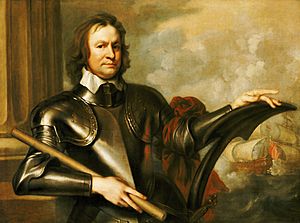Richard Deane (regicide) facts for kids
Richard Deane was an important English leader who lived from 1610 to 1653. He supported the Parliamentarian side, also known as the Roundheads, during a big conflict called the Wars of the Three Kingdoms. This was a series of wars in England, Scotland, and Ireland. Deane became a high-ranking officer, both on land as a major-general and at sea as a General at Sea. He was also one of the people who signed the document leading to the trial and execution of King Charles I.
Contents
Early Life and Military Career
Richard Deane was born in Gloucestershire, England, and was baptized on July 8, 1610. His family was known for being Puritan, a group of strict Protestants. They were connected to many families who supported Oliver Cromwell during the English Civil War.
Not much is known about Deane's early life. However, it seems he had some training on ships, possibly even on a warship. When the Civil War began, he joined the Parliamentarian army. He started as a volunteer in the artillery, which uses large guns. He continued to work with artillery throughout his career.
Rising Through the Ranks
In 1644, Deane was an artillery commander under a leader named Essex. He was part of a surrender after a battle in Cornwall. Essex called him "an honest, judicious and stout man." This means he was seen as a good, smart, and brave officer.
After this, Deane became the comptroller of the ordnance. This meant he was in charge of the army's weapons and supplies. He led the artillery at the important Battle of Naseby in 1645. He also served during another campaign in western England.
In 1647, Deane was promoted to colonel and given his own regiment, which is a large group of soldiers. He was a strong supporter of Oliver Cromwell.
Key Battles and Roles
When the war started again in 1648, Deane joined Cromwell in Wales. As a brigadier-general, he led the right side of the army at the Battle of Preston. His leadership helped the Parliamentarians win this important battle.
Later in 1648, Deane helped the army take control of London. He was a trusted supporter of Cromwell. He played a big part in the events that led to the trial of King Charles I. Deane was one of the people who helped decide the King's fate. He also signed the document that led to the King's execution on January 30, 1649.
General at Sea
After the King's execution, Deane's skills were needed for the navy. In 1649, he became one of the first "Generals at Sea." This was a new position that put him in charge of the navy. He shared this role with two other important leaders, Edward Popham and Robert Blake.
In 1651, Deane briefly returned to the army as a major-general. He fought in the Battle of Worcester. After this, he helped manage the settlement of Scotland and commanded both the army and navy there.
At the end of 1652, Deane went back to his role as General at Sea. He fought alongside Blake in the Battle of Portland in 1653. He also played a major role in getting the fleet ready and reorganizing the navy.
Death and Burial
Richard Deane was killed at the start of the Battle of the Gabbard on June 1, 1653. His body was displayed in Greenwich. After a public funeral, he was buried in Henry VII's chapel at Westminster Abbey. However, after the monarchy was restored in England, his body was removed from the Abbey.
Family Life
Richard Deane had a daughter named Hannah. She became the fourth wife of Godwin Swift. Godwin Swift was a lawyer who worked for the Duke of Ormonde in County Tipperary. He was also the uncle and guardian of the famous writer Jonathan Swift.


